Columbus is a Latinized version of the Italian surname "Colombo". It most commonly refers to:
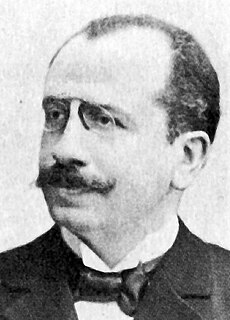
Albert Ballin was a German shipping magnate. He was the general director of the Hamburg-Amerikanische Packetfahrt-Actien-Gesellschaft (HAPAG) or Hamburg-America Line, which for a time was the world's largest shipping company. Being the inventor of the concept of the cruise ship, he is known as the father of modern cruise ship travel.
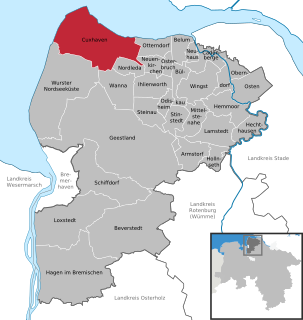
Cuxhaven is an independent town and seat of the Cuxhaven district, in Lower Saxony, Germany. The town includes the northernmost point of Lower Saxony. It is situated on the shore of the North Sea at the mouth of the Elbe River. Cuxhaven has a footprint of 14 kilometres (east–west) by 7 km (4 mi) (north–south). Its town quarters Duhnen, Döse and Sahlenburg are especially popular vacation spots on the North Sea and home to about 52,000 residents.
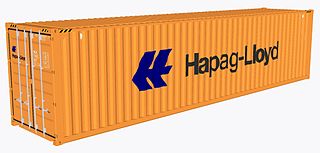
Hapag-Lloyd AG is a German international shipping and container transportation company. It is currently the world's fifth largest container carrier in terms of vessel capacity.

SS Deutschland was a 21,046 gross registered ton (GRT) German HAPAG ocean liner which was sunk in a British air attack on May 3, 1945 when it was in the process of being converted as a hospital ship. All people on-board the Deutschland survived the attack, though two accompanying vessels sank with great loss of life.

The Hamburg-Amerikanische Packetfahrt-Aktien-Gesellschaft (HAPAG), often referred to as Hamburg America Line, was a transatlantic shipping enterprise established in Hamburg, in 1847. Among those involved in its development were prominent citizens such as Albert Ballin, Adolph Godeffroy, Ferdinand Laeisz, Carl Woermann, August Bolten, and others, and its main financial backers were Berenberg Bank and H. J. Merck & Co. It soon developed into the largest German, and at times the world's largest, shipping company, serving the market created by German immigration to the United States and later immigration from Eastern Europe. On 1 September 1970, after 123 years of independent existence, HAPAG merged with the Bremen-based North German Lloyd to form Hapag-Lloyd AG.

Norddeutscher Lloyd (NDL) was a German shipping company. It was founded by Hermann Henrich Meier and Eduard Crüsemann in Bremen on 20 February 1857. It developed into one of the most important German shipping companies of the late 19th and early 20th centuries, and was instrumental in the economic development of Bremen and Bremerhaven. On 1 September 1970, the company merged with Hamburg America Line (HAPAG) to form Hapag-Lloyd AG.
Widder was an auxiliary cruiser (Hilfskreuzer) of Nazi Germany's Kriegsmarine that was used as a merchant raider in the Second World War. Her Kriegsmarine designation was Schiff 21, to the Royal Navy she was Raider D. The name Widder (Ram) represents the constellation Aries in German.
The Italian Line or Italia Line, whose official name was Italia di Navigazione S.p.A., was a passenger shipping line that operated regular transatlantic services between Italy and the United States, and Italy and South America. During the late 1960s the company turned to running cruises, and from 1981 it became a global freight operator.

RMS Majestic was a White Star ocean liner working on the North Atlantic run, originally launched in 1914 as the Hamburg America Line liner SS Bismarck. At 56,551 gross register tons, she was the largest ship in the world until completion of SS Normandie in 1935.

Prinzessin Victoria Luise was a German passenger ship of the Hamburg-America Line (HAPAG) of some 4,409 gross register tons (GRT). She is credited with having been the first purpose-built cruise ship. Launched on 29 June 1900, she served with HAPAG until 16 December 1906 after being accidentally grounded off Jamaica.

The first SS Fürst Bismarck was an ocean liner built in 1890 by AG Vulcan for the Hamburg America Line. A steamship of 8,430 gross register tons, it was assigned to transatlantic crossings between Hamburg Germany and New York City, United States. Fürst Bismarck and the sister ships were part of an express fleet that usually made the trip in five to six days.
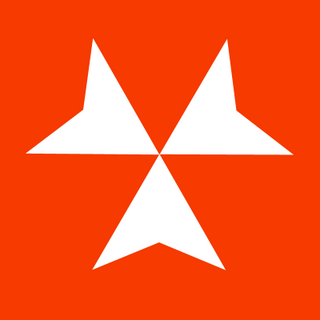
Hamburg Atlantic Line was an ocean liner and cruise ship operating company established in Hamburg, West Germany in 1958 by Axel Bitsch Christensen and Vernicos Eugenides, the latter being the adopted son of Home Lines' founder Eugen Eugenides. In 1966 the company changed its name to German Atlantic Line. Liner services were abandoned in 1969, after which the company's ships concentrated solely on cruising. Due to the 1973 oil crisis, German Atlantic Line closed down in December 1973.
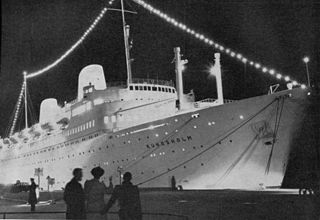
MS Kungsholm was a combined ocean liner / cruise ship built in 1953 by the De Schelde shipyard in Vlissingen, the Netherlands for the Swedish American Line. Between 1965 and 1981 she sailed for the North German Lloyd and their successor Hapag-Lloyd as MS Europa. From 1981 until 1984 she sailed for Costa Cruises as MS Columbus C. She sank in the port of Cadiz, Spain after ramming a breakwater on 29 July 1984. The vessel was refloated later that year, but sent to a Barcelona shipbreaker in 1985 for scrapping.
United American Lines, the common name of the American Shipping and Commercial Corporation, was a shipping company founded by W. Averell Harriman in 1920. Intended as a way for Harriman to make his mark in the business world outside of his father, railroad magnate E. H. Harriman, the company was financed by the younger Harriman's mother, Mary Williamson Averell. Entering into the shipping world with little experience, Harriman's United American Lines entered into agreements with the Hamburg America Line, which was determined to recover after the financial disaster that befell the German company as a result of World War I.
Lykes Bros. Steamship Co., also called Lykes Lines, was a cargo shipping company acting from the beginning of the 20th century to 2005 having its main business in the trade to and from the United States.
Thuringia was an 11,251 GRT ocean liner that was built in 1922 by Howaldtswerke, Kiel, Germany for the Hamburg Amerikanische Paketfahrt AG, Hamburg. In 1930, she was renamed General San Martin. In 1934, she was chartered by Hamburg-Südamerikanische Dampfschiffahrts-Gesellschaft and sold to them in 1936. She was requisitioned by the Kriegsmarine in 1940 and served until 1945 as a barracks ship, and then as passenger ship during the evacuation of civilians from the Baltic.
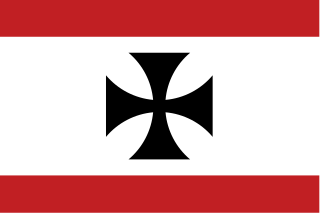
DDG Hansa, short for Deutsche Dampfschiffahrts-Gesellschaft Hansa was a major German shipping company specialising in heavy freight and scheduled traffic between Europe and the Far East. Founded in Bremen in 1881, the company declared bankruptcy in 1980.

SS Burdigala previously SS Kaiser Friedrich – was a French and ex-German ocean liner that hit a mine laid by U-73 in the Aegean sea 2 nautical miles (3.7 km) southwest off Kea, Greece, while she was travelling from Thessaloniki, Greece to Toulon, France.
Prinz Waldemar was a steam passenger-cargo ship built in 1902 by the Reiherstieg Schiffswerfte & Maschinenfabrik of Hamburg for Hamburg America Line (HAPAG). She was named after Prince Waldemar of Prussia. The ship was primarily employed as a passenger and cargo carrier between Hamburg and South America during her career.












